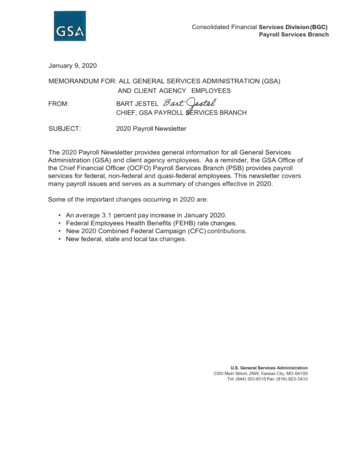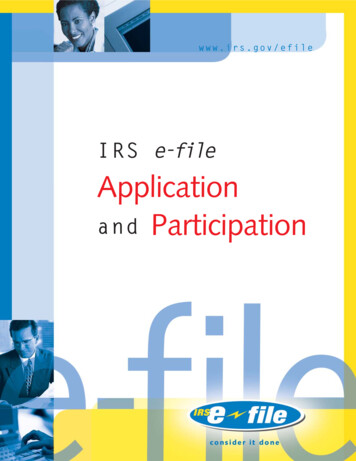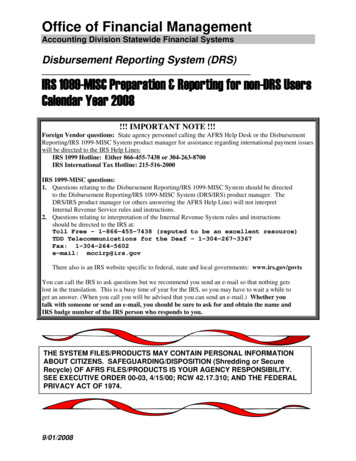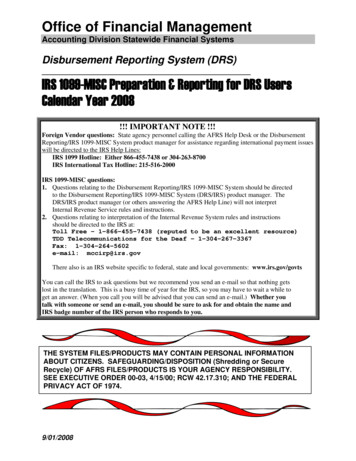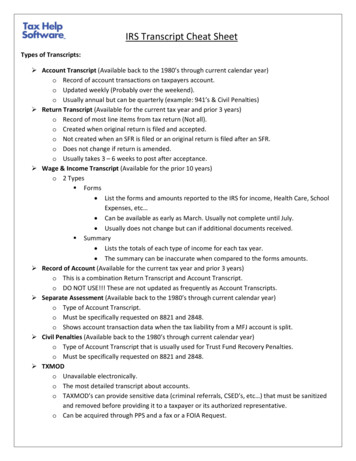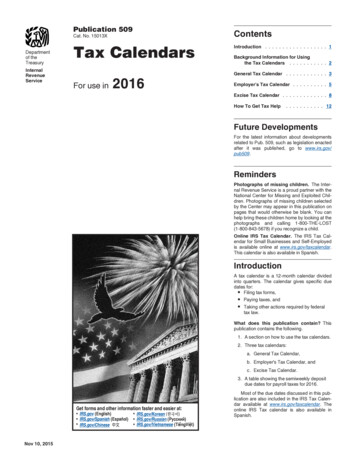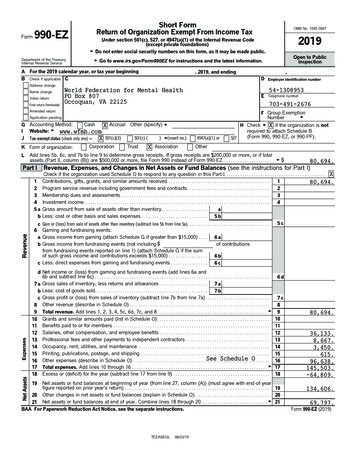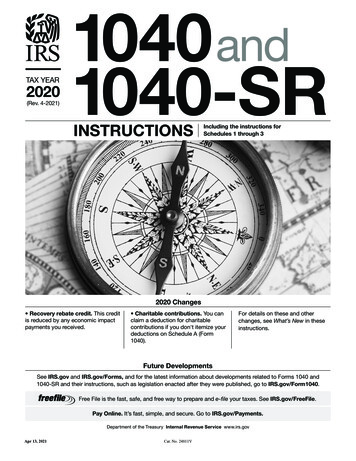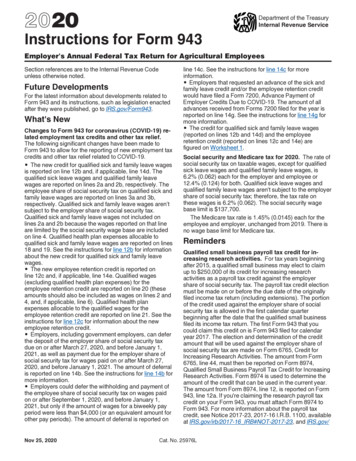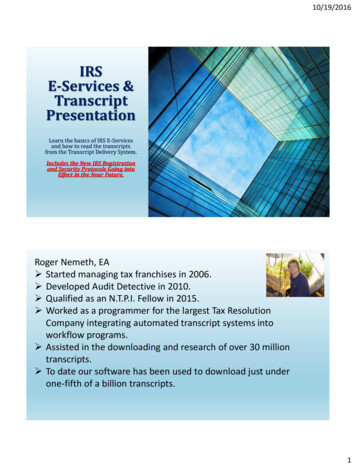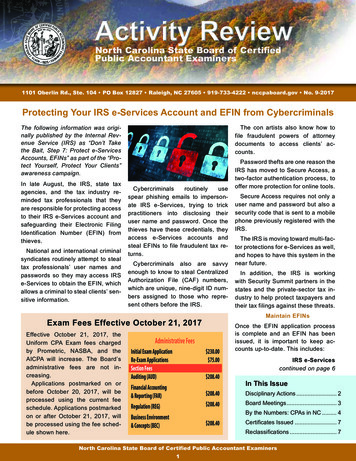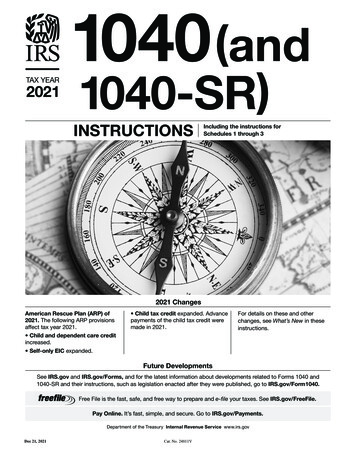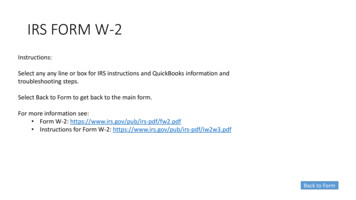
Transcription
IRS FORM W-2Instructions:Select any any line or box for IRS instructions and QuickBooks information andtroubleshooting steps.Select Back to Form to get back to the main form.For more information see: Form W-2: https://www.irs.gov/pub/irs-pdf/fw2.pdf Instructions for Form W-2: https://www.irs.gov/pub/irs-pdf/iw2w3.pdfBack to Form
Box - VoidIRS Instructions:Void. Check this box when an error is made on Form W-2 and you are voiding itbecause you are going to complete a new Form W-2. Do not include anyamounts shown on “Void” forms in the totals you enter on Form W-3. SeeCorrections.How QuickBooks populates this line:This box is not checked.Back to Form
Box a - Employee's social security numberIRS Instructions:Employee's social security number. Enter the number shown on the employee's social security card.If the employee does not have a card, he or she should apply for one by completing Form SS-5, Applicationfor a Social Security Card. The SSA lets you verify employee names and SSNs online. For information aboutthese free services, visit the Employer W-2 Filing Instructions & Information website at SSA.gov/employer. Ifyou have questions about using these services, call 800-772-6270 (toll free) to speak with an employerreporting technician at the SSA.If the employee has applied for a card but the number is not received in time for filing, enter “Applied For” inbox a on paper Forms W-2 filed with the SSA. If e-filing, enter zeros (000-00-0000 if creating forms online or000000000 if uploading a file).Ask the employee to inform you of the number and name as they are shown on the social security card whenit is received. Then correct your previous report by filing Form W-2c showing the employee's SSN. If theemployee needs to change his or her name from that shown on the card, the employee should call the SSA at800-772-1213.How QuickBooks populates this line:QuickBooks uses the employee's Social Security number from the employee'srecord to fill in this box.To verify the Employee social security number in your QuickBooks Online: Click Workers Employees tab and click the employee name toaccess their Employee details. Click Edit Employee to update the employeeinformation. Desktop: Click Employee Center Employees tab, and double-click on thename to access the Personal Info tab where you can edit the Social Securitynumber.If you do not provide the correct employee name and SSN on Form W-2, you may owe a penalty unless youhave reasonable cause. For more information, see Pub. 1586, Reasonable Cause Regulations & Requirementsfor Missing and Incorrect Name/TINs.ITINs for aliens. Do not accept an ITIN in place of an SSN for employee identification or for work. An ITIN isonly available to resident and nonresident aliens who are not eligible for U.S. employment and needidentification for other tax purposes. You can identify an ITIN because it is a 9-digit number formatted like anSSN beginning with the number “9” and with a number in one of the following ranges in the fourth and fifthdigit: 50–65, 70–88, 90–92, and 94–99 (for example, 9NN-70-NNNN). An individual with an ITIN who laterbecomes eligible to work in the United States must obtain an SSN.CAUTION: Do not auto-populate an ITIN into box a.Back to Form
Box b - Employer identification number (EIN)IRS Instructions:How QuickBooks populates this line:Employer identification number (EIN). Show the EIN assigned to you bythe IRS (00-0000000). This should be the same number that you used onyour federal employment tax returns (Forms 941, 941-SS, 943, 944, CT1, or Schedule H (Form 1040)). Do not use a prior owner's EIN. If you donot have an EIN when filing Forms W-2, enter “Applied For” in box b; donot use your SSN. You can get an EIN by applying online at ne, or by filing Form SS-4, Application forEmployer Identification Number. Also see Agent reporting.QuickBooks pulls this information from the EIN (Federal Employer IdentificationNumber) field.To verify your EIN in QuickBooksDepending on your payroll service, you may need to contact us to change yourEIN. Online: Select the Gear icon Payroll Settings FederalTaxes. Under Federal Tax Setup, update your EIN. Desktop: To change your EIN, click on Company and then on MyCompany. Click the edit icon and click the Company Information tab. Enterthe correct EIN in the Federal Employer Identification Number field, andclick OK. You will have to create a new form once you've changed yourcompany EIN.Back to Form
Box c - Employer's name, address, and ZIPcodeIRS Instructions:How QuickBooks populates this line:Employer's name, address, and ZIP code. This entry shouldbe the same as shown on your Forms 941, 941-SS, 943, 944,CT-1, or Schedule H (Form 1040). The U.S. Postal Servicerecommends that no commas or periods be used in returnaddresses. Also see Agent reporting. Online: QuickBooks Online pulls this information from the data provided in the CompanyGeneral Tax Information window. Desktop: QuickBooks Desktop pulls this information from data provided in the "LegalInformation" section of the company information window.To verify your Employer name and address in QuickBooks Online: Select the Gear icon Payroll Settings General Taxinformation. Under Company General Tax Information update your Filing Name and FilingAddress. Desktop: From the Company menu, choose My Company. Click the edit icon and clickthe Contact Information and Legal Information tabs to make any necessary correction to theaddress, and click OK. You will have to create a new form once you've change your companyaddress.Back to Form
Box d - Control numberIRS Instructions:How QuickBooks populates this line:Control number. You may use this box to identify individual FormsW-2. You do not have to use this box.QuickBooks does not supply this information.Back to Form
Box e and f—Employee's name and addressIRS Instructions:How QuickBooks populates this line:Employee's name and address. Enter the name as shown on your employee's social securitycard (first name, middle initial, last name). If the name does not fit in the space allowed on theform, you may show the first and middle name initials and the full last name. It is especiallyimportant to report the exact last name of the employee. If you are unable to determine thecorrect last name, use of the SSA's Social Security Number Verification System may be helpful.QuickBooks uses the First Name, M.I., and Last Name and Home Addressfields in the employee record to fill in the employee's name and address foryou. The name in the employee record should match the name on theemployee's Social Security card. If you have used "Jr.," "Sr.," or any similarsuffix, that information will appear at the end of the employee's last name.Separate parts of a compound name with either a hyphen or a blank. Do not join them into asingle word. Include all parts of a compound name in the appropriate name field. For example,for the name “John R Smith-Jones,” enter “Smith-Jones” or “Smith Jones” in the last name field.To verify your QuickBooks result Online: Click Workers Employees tab and click the employee name toverify their Employee details. Click Edit Employee to update theemployee information if needed.If the name has changed, the employee must get a corrected social security card from any SSA Desktop: Click the Employee Center, click the Employees tab and doubleoffice. Use the name on the original card until you see the corrected card.click the name to edit if needed.When an employee's name changes (e.g., marriage or divorce), have theDo not show titles or academic degrees, such as “Dr.,” “RN,” or “Esq.,” at the beginning or end of employee contact any Social Security office to get a new Social Security card.the employee's name. Generally, do not enter “Jr.,” “Sr.,” or other suffix in the “Suff.” box on CopyA unless the suffix appears on the card. However, the SSA still prefers that you do not enter thesuffix on Copy A.Include in the address the number, street, and apartment or suite number (or P.O. box number ifmail is not delivered to a street address). The U.S. Postal Service recommends that no commasor periods be used in delivery addresses. For a foreign address, give the information in thefollowing order: city, province or state, and country. Follow the country's practice for enteringthe postal code. Do not abbreviate the country nameBack to Form
Box 1 - Wages, tips, other compensationagricultural wages.13. Designated Roth contributions made under a section 401(k) plan, a section 403(b) salaryWages, tips, other compensation. Show the total taxable wages, tips, and other compensationreduction agreement, or a governmental section 457(b) plan. See Designated Roththat you paid to your employee during the year. However, do not include elective deferrals (suchcontributions.as employee contributions to a section 401(k) or 403(b) plan) except section 501(c) (18)14. Distributions to an employee or former employee from an NQDC plan (including a rabbi trust)contributions. Include the following.or a nongovernmental section 457(b) plan.1. Total wages, bonuses (including signing bonuses), prizes, and awards paid to employees15. Amounts includible in income under section 457(f) because the amounts are no longerduring the year. See Calendar year basis.subject to a substantial risk of forfeiture.2. Total noncash payments, including certain fringe benefits. See Fringe benefits.16. Payments to statutory employees who are subject to social security and Medicare taxes but3. Total tips reported by the employee to the employer (not allocated tips).not subject to federal income tax withholding must be shown in box 1 as other compensation.4. Certain employee business expense reimbursements. See Employee business expenseSee Statutory employee.reimbursements.17. Cost of current insurance protection under a compensatory split-dollar life insurance5. The cost of accident and health insurance premiums for 2%-or-more shareholder-employeesarrangement.paid by an S corporation.18. Employee contributions to a health savings account (HSA).6. Taxable benefits from a section 125 (cafeteria) plan if the employee chooses cash.19. Employer contributions to an HSA if includible in the income of the employee. See Health7. Employee contributions to an Archer MSA.savings account (HSA).8. Employer contributions to an Archer MSA if includible in the income of the employee. See20. Amounts includible in income under an NQDC plan because of section 409A. See NonqualifiedArcher MSA.deferred compensation plans under Special Reporting Situations for Form W-2.9. Employer contributions for qualified long-term care services to the extent that such coverage 21. Nonqualified moving expenses and expense reimbursements. See Moving expenses.is provided through a flexible spending or similar arrangement.22. Payments made to former employees while they are on active duty in the Armed Forces or10. Taxable cost of group-term life insurance in excess of 50,000. See Group-term life insurance.other uniformed services.11. Unless excludable under Educational assistance programs, payments for non-job-related23. All other compensation, including certain scholarship and fellowship grants. See Scholarshipeducation expenses or for payments under a nonaccountable plan. See Pub. 970.and fellowship grants. Other compensation includes taxable amounts that you paid to your12. The amount includible as wages because you paid your employee's share of social securityemployee from which federal income tax was not withheld. You may show otherand Medicare taxes (or railroad retirement taxes, if applicable). See Employee's social securitycompensation on a separate Form W-2. See Multiple forms.and Medicare taxes (or railroad retirement taxes, if applicable) paid by employer. If you alsopaid your employee's income tax withholding, treat the grossed-up amount of thatwithholding as supplemental wages and report those wages in boxes 1, 3, 5, and 7. (Use boxContinued on next page14 if railroad retirement taxes apply.) No exceptions to this treatment apply to household orIRS Instructions:Back to Form
Box 1 - Wages, tips, other compensationcontinuedHow QuickBooks populates this line:Pro Tip:QuickBooks calculates the total wages, tips, bonuses, overtime pay, etc., that are subject to federalincome tax, and paid to the employee during the reporting year. Wages earned in the reporting year,but paid in the following year, are not included. Certain deductions that are not taxable to federalincome tax such as 401(k), pre-tax medical, fringe benefits, etc., can affect this box.Box 1 is reduced by pre-tax deductions including retirementplans such as 401(k), only wages subject to federal income taxare shown in this box.To verify your QuickBooks resultOnline:Click to learn about the Taxability of pay types and deductions how they affect this box.1. Select Reports and search for the Payroll Details Report.2. Filter by year and the Employee, then click Run Report.3. Review the wages and deductions paid to the employee.Desktop:1. Run the Payroll Item Listing report.2. Filter the report. In the columns, clear everything except the Payroll Item and Tax Tracking Type.3. Print the report.4. Put a check mark next to any item that has a tax tracking type of Compensation, Reported tips,dependent care FSA, Section 457 Distribution, Non-qual. Plan Distr., Fringe Benefits, Other MovingExpenses, 401(k), 403(b), 408(k)(6)SEP, Elective 457(b), Simple IRA, Taxable Grp Trm Life, Med CareFlex Spend, Premium Only/125, SCorp Pd Med Premium.5. Now run a Payroll Summary report for the calendar year.6. Click Customize Report.7. Click the Filters tab.8. Under Current filter choices, click Payroll Item.9. In the drop-down box in the middle, pick Multiple Payroll Items. Check off all the payroll items youmarked earlier. If any of them are incorrect, the tax tracking type needs to be modified.Previous pageBack to Form
Box 2 - Federal income tax withheldBack to FormIRS Instructions:Federal income tax withheld.Show the total federal income tax withheld from the employee's wages forthe year. Include the 20% excise tax withheld on excess parachute payments.See Golden parachute payments.For Forms W-2AS, W-2CM, W-2GU, or W-2VI, show the total AmericanSamoa, CNMI, Guam, or U.S. Virgin Islands income tax withheld.How QuickBooks populates this line:QuickBooks calculates federal income tax withheld from the employee'swages.To verify your QuickBooks result Online: Run a Payroll Details Report. Look for the FIT amount andcompare the numbers. Desktop: Run a Payroll Summary report for the entire calendar year. Thenumber is equal to the amount of the Federal Withholding item. Thisnumber can be double-clicked to see what transactions contribute tothe total.
Box 3 - Social security wagesWages reported in box 3 also include: Signing bonuses an employer pays for signing or ratifying an employment contract. See Rev. Rul.Social security wages.2004-109, 2004-50 I.R.B. 958 available at IRS.gov/irb/ 2004-50 IRB#RR-2004-109.Show the total wages paid (before payroll deductions) subject to employee social security tax but not Taxable cost of group-term life insurance over 50,000 included in box 1. See Group-term lifeincluding social security tips and allocated tips. If reporting these amounts in a subsequent year (dueinsurance.to lapse of risk of forfeiture), the amount must be adjusted by any gain or loss. See Box 7 Social Cost of accident and health insurance premiums for 2%-or-more shareholder-employees paid bysecurity tips and Box 8 Allocated tips. Generally, noncash payments are considered to be wages.an S corporation, but only if not excludable under section 3121(a)(2)(B).Include employee business expense reimbursements and moving expenses reported in box 1. If you Employee and nonexcludable employer contributions to an MSA or HSA. However, do not includepaid the employee's share of social security and Medicare taxes rather than deducting them fromemployee contributions to an HSA that were made through a cafeteria plan. See Archer MSA andwages, see Employee's social security and Medicare taxes (or railroad retirement taxes, if applicable)Health savings account (HSA).paid by employer. The total of boxes 3 and 7 cannot exceed 128,400 (2018 maximum social security Employee contributions to a SIMPLE retirement account. See SIMPLE retirement account.wage base). Adoption benefits. See Adoption benefits.IRS Instructions:Report in box 3 elective deferrals to certain qualified cash or deferred compensation arrangementsand to retirement plans described in box 12 (codes D, E, F, G, and S) even though the deferrals arenot includible in box 1. Also report in box 3 designated Roth contributions made under a section401(k) plan, under a section 403(b) salary reduction agreement, or under a governmental section457(b) plan described in box 12 (codes AA, BB, and EE).How QuickBooks populates this line:QuickBooks calculates the total wages subject to employee Social Security tax, not including SocialSecurity tips (box 7) or allocated tips (box 8), up to the maximum amount.To verify your QuickBooks resultAmounts deferred (plus earnings or less losses) under a section 457(f) or nonqualified plan ornongovernmental section 457(b) plan must be included in boxes 3 and/or 5 as social security and/or Online: Run a Payroll Details Report for the entire year. Look at the pay amount minus anydeductions not subject to Social Security. Click to learn about the Taxability of pay types andMedicare wages as of the later of when the services giving rise to the deferral are performed or whendeductions how they affect this box.there is no substantial forfeiture risk of the rights to the deferred amount. Include both elective and Desktop: Run a Payroll Summary report and double-click on the amount of Social Security Employeenonelective deferrals for purposes of nongovernmental section 457(b) plans.for the employee in question. The number is equal to the wage base total minus the wage base tipstotal.Pro Tip:Box 3 is reduced by pre-tax deductions like medical insurance, however most retirement plans including401(k) are still subject to social security tax and won’t reduce this box.Back to Form
Box 4 - Social security tax withheldIRS Instructions:Social security tax withheld.Show the total employee social security tax (not your share) withheld, including socialsecurity tax on tips. For 2018, the amount should not exceed 7,960.80 ( 128,400 6.2%).Include only taxes withheld (or paid by you for the employee) for 2018 wages and tips. If youpaid your employee's share, see Employee's social security and Medicare taxes (or railroadretirement taxes, if applicable) paid by employer.How QuickBooks populates this line:QuickBooks calculates the amount of Social Security tax withheld from theemployee's wages (box 3) and tips (box 7), up to the maximum amount.To verify your QuickBooks result Online: Run a Payroll Details Report for the entire year. Look atthe amount of Social Security tax withheld. Desktop: Run a Payroll Summary report for the entire calendar year.The amount for Social Security Employee will be equal to the number inthis box. The amount can be double-clicked to see what transactionscontribute to the total.Pro Tip:This box includes all social security withheld,including social security withheld on tips that arereported in box 7.Back to Form
Box 5 - Medicare wages and tipsIRS Instructions:How QuickBooks populates this line:Medicare wages and tips.The wages and tips subject to Medicare tax are the same as those subject to socialsecurity tax (boxes 3 and 7) except that there is no wage base limit for Medicaretax. Enter the total Medicare wages and tips in box 5. Be sure to enter tips that theemployee reported even if you did not have enough employee funds to collect theMedicare tax for those tips. See Box 3 Social security wages, for payments to reportin this box. If you paid your employee's share of taxes, see Employee's socialsecurity and Medicare taxes (or railroad retirement taxes, if applicable) paid byemployer.QuickBooks calculates total gross wages subject to Medicare tax, notincluding allocated tips (box 8).If you are a federal, state, or local governmental agency with employees paying onlyMedicare tax, enter the Medicare wages in this box. See Government employers.Example of how to report social security and Medicare wages. You paid youremployee 140,000 in wages. Enter in box 3 (social security wages) 128400.00 butenter in box 5 (Medicare wages and tips) 140000.00. There is no limit on theamount reported in box 5. If the amount of wages paid was 128,400 or less, theamounts entered in boxes 3 and 5 will be the same.To verify your QuickBooks result Online: Run a Payroll Details Report for the entire year. Look at the payamount minus any deductions not subject to Medicare. Click to learnabout the Taxability of pay types and deductions how they affect thisbox. Desktop: Run a Payroll Summary report for the entire calendar year.Double-click on the amount of Medicare Employee. This is the total ofthe wage base column.Pro Tip:Box 5 is reduced by pre-tax deductions like medical insurance, however mostretirement plans including 401(k) are still subject to medicare tax and won’t reducethis box.Back to Form
Box 6 - Medicare tax withheldIRS Instructions:Medicare tax withheld.Enter the total employee Medicare tax (including any Additional Medicare Tax)withheld. Do not include your share. Include only tax withheld for 2018 wagesand tips. If you paid your employee's share of the taxes, see Employee's socialsecurity and Medicare taxes (or railroad retirement taxes, if applicable) paid byemployer.For more information on Additional Medicare Tax, go to IRS.gov/ADMT.How QuickBooks populates this line:QuickBooks calculates the amount of Medicare tax (including any AdditionalMedicare Tax) withheld from the employee's wages (box 5) for the year. It usestwo items for this calculation: Medicare Employee and Medicare Employee AddlTax.To verify your QuickBooks Desktop result Online: Run a Payroll Details Report for the entire year. Look at the amountof Medicare tax withheld. Desktop: Run a Payroll Summary report for the entire calendar year. Thenumber is equal to the amount of Medicare Employee plus the amount ofMedicare Employee Addl Tax. The amounts can be double-clicked to see whattransactions contribute to the total.Back to Form
Box 7 - Social security tipsIRS Instructions:How QuickBooks populates this line:Social security tips.Show the tips that the employee reported to you even if you did not have enoughemployee funds to collect the social security tax for the tips. The total of boxes 3and 7 should not be more than 128,400 (the maximum social security wagebase for 2018). Report all tips in box 1 along with wages and other compensation.Include any tips reported in box 7 in box 5 also.QuickBooks populates the amount of employee-reported tips.To verify your QuickBooks result Online: Run a Payroll Details Report for the entire year. Look atthe amount of Cash Tips. Desktop: Run a Payroll Summary report for the entire calendar year.The number is equal to the amount of the Reported Tips item (anyitem that has a tax tracking type of Reported Tips). You can doubleclick the amount to see what transactions contribute to the total.Back to Form
Box 8 - Allocated tips (not applicable to FormsW-2AS, W-2CM, W-2GU, or W-2VI)IRS Instructions:Allocated tips (not applicable to Forms W-2AS, W-2CM, W-2GU,or W-2VI).If you operate a large food or beverage establishment, show thetips allocated to the employee. See the Instructions for Form8027, Employer's Annual Information Return of Tip Income andAllocated Tips. Do not include this amount in box 1, 3, 5, or 7.Box 9—VerificationHow QuickBooks populates this line:Enter in box 8 of the W-2 Worksheet the total of tips allocated to theemployee based upon IRS Form 8027.To verify your QuickBooks result Online: Contact us to update this number. Desktop, you may be able to add the amount yourself, or create apayroll item to track the amount. See Create an allocated tips payrollitem for details.Pro Tip:Allocated tips are tips allocated in by the employer to make up forunder-reported tips by the employee, per IRS guidelines. All other tipsare not allocated tips.Back to Form
Box 9 - Verification code (not applicable toForms W-2AS, W-2CM, W-2GU, or W-2VI)IRS Instructions:Verification code (not applicable to Forms W-2AS, W-2CM, W2GU, or W-2VI).If you are participating in the W-2 Verification Code pilot, enter theappropriate verification code in box 9 on Copies B and C.Otherwise, leave box 9 blank. For more information, seeIRS.gov/Individuals/W-2-Verification-Code.How QuickBooks populates this line:Starting 2018Back to Form
Box 10 - Dependent care benefits (not applicableto Forms W-2AS, W-2CM, W-2GU, or W-2VI)IRS Instructions:Dependent care benefits (not applicable to Forms W-2AS, W-2CM, W-2GU, orW-2VI). Show the total dependent care benefits under a dependent careassistance program (section 129) paid or incurred by you for your employee.Include the fair market value (FMV) of care in a daycare facility provided orsponsored by you for your employee and amounts paid or incurred fordependent care assistance in a section 125 (cafeteria) plan. Report all amountspaid or incurred (regardless of any employee forfeitures), including those inexcess of the 5,000 exclusion. This may include (a) the FMV of benefits providedin kind by the employer, (b) an amount paid directly to a daycare facility by theemployer or reimbursed to the employee to subsidize the benefit, or (c) benefitsfrom the pre-tax contributions made by the employee under a section 125dependent care flexible spending account. Include any amounts over 5,000 inboxes 1, 3, and 5. For more information, see Pub. 15-B.TIP: An employer that amends its cafeteria plan to provide a grace period fordependent care assistance may continue to rely on Notice 89-111 by reporting inbox 10 the salary reduction amount elected by the employee for the year fordependent care assistance (plus any employer matching contributionsattributable to dependent care). Also see Notice 2005-42, 2005-23 I.R.B. 1204,available at IRS.gov/irb/ 2005-23 IRB#NOT-2005-42 and Notice 2005-61, 200539 I.R.B. 607, available at IRS.gov/node/ 51071#NOT-2005-61.How QuickBooks populates this line:QuickBooks populates deductions for Dependent Care FSA, includingamounts in a Section 125 (cafeteria) plan, up to the annual limit.To verify your QuickBooks result Online: Run a Payroll Details Report for the entire year. Look atthe amount of Dependent Care FSA you withheld. Desktop: Run a Payroll Summary report for the entire calendar year.The amount for Dependent Care FSA and Co. Paid Dep. Care will beequal to the number in this box. You can double-click the amount tosee what transactions contribute to the total.Pro Tip:Not all 125 plans fall into Box 10, only qualified dependent care.Back to Form
Box 11 - Nonqualified plansAdministration, and Form SSA-131, Employer Reportof Special Wage Payments, for instructions onNonqualified plans. The purpose of box 11 is for the reporting these and other kinds of compensationSSA to determine if any part of the amount reported earned in prior years. However, do not file Form SSAin box 1 or boxes 3 and/or 5 was earned in a prior131 if this situation applies and the employee wasyear. The SSA uses this information to verify that they not 61 years old or more during the tax year forhave properly applied the social security earnings test which you are filing Form W-2.and paid the correct amount of benefits.Unlike qualified plans, NQDC plans do not meet theReport distributions to an employee from aqualification requirements for tax-favored status fornonqualified plan or nongovernmental section 457(b) this purpose. NQDC plans include those arrangementsplan in box 11. Also report these distributions in box traditionally viewed as deferring the receipt of current1. Make only one entry in this box. Distributions from compensation. Accordingly, welfare benefit plans,governmental section 457(b) plans must be reported stock option plans, and plans providing dismissal pay,on Form 1099-R, not in box 1 of Form W-2.termination pay, or early retirement pay generally arenot NQDC plans.Under nonqualified plans or nongovernmental 457(b)plans, deferred amounts that are no longer subject to Report distributions from NQDC or section 457 plansa substantial risk of forfeiture are taxable even if not to beneficiaries of deceased employees on Formdistributed. Report these amounts in boxes 3 (up to 1099-MISC, not on Form W-2.the social security wage base) and 5. Do not report inbox 11 deferrals included in boxes 3 and/or 5 andMilitary employers must report military retirementdeferrals for current year services (such as those with payments on Form 1099-R. Do not report specialno risk of forfeiture).wage payments, such as accumulated sick pay orvacation pay, in box 11. For more information onCAUTION: If you made distributions and also arereporting special wage payments, see Pub. 957.reporting any deferrals in boxes 3 and/or 5, do notcomplete box 11. See Pub. 957, Reporting Back Payand Special Wage Payments to the Social SecurityIRS Instructions:How QuickBooks populates this line: QuickBooks Online - this box is not supported QuickBooks Desktop calculates Section 457 distributions in box 11 based uponpayroll items used on employee paychecks.To verify your QuickBooks resultDesktop: Run a Payroll Summary report for the entire calendar year. Review theamount distributed to employees. You can double-click the amount to see whattransactions contribute to the total.Back to Form
Box 12 - CodesIRS Instructions:Codes.
How QuickBooks populates this line: QuickBooks uses the employee's Social Security number from the employee's record to fill in this box. To verify the Employee social security number in your QuickBooks Online: Click Workers Employees tab and click the employee name to access their Employee details. Click Edit Employee to update the employee
